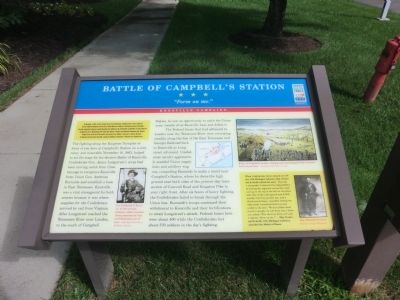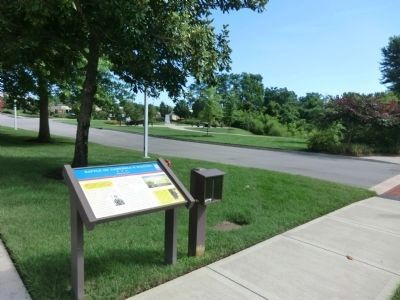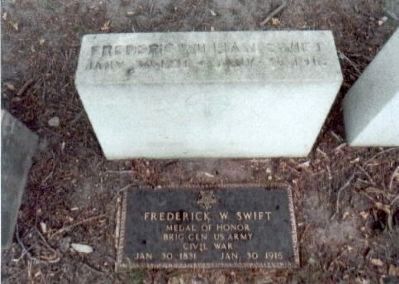Farragut in Knox County, Tennessee — The American South (East South Central)
Battle of Campbell's Station
"Form on me."
On November 4, 1863, to divert Federal forces from Chattanooga, Confederate Gen. James Longstreet led two reinforced divisions from the city to attack Union Gen. Ambrose E. Burnside’s garrison in Knoxville. Burnside confronted Longstreet outside Knoxville, then withdrew to his fortification on November 17, and Longstreet besieged the city. In Chattanooga, after Union Gen. Ulysses S. Grant’s army defeated Confederate Gen. Braxton Bragg’s forces at the end of the month, Grant ordered Gen. William T. Sherman to reinforce Burnside. As Sherman marched toward Knoxville, Longstreet withdrew on December 4. Sherman soon rejoined Grant.
(main text)
The fighting along the Kingston Turnpike in front of you here at Campbell’s Station on a cold, rainy, and miserable November 16, 1863, helped to set the stage for the decisive Battle of Knoxville. Confederate Gen. James Longstreet’s corps had been moving north from Chattanooga to recapture Knoxville from Union Gen. Ambrose Burnside and establish a base in East Tennessee. Knoxville was a vital strongpoint for both armies because it was where supplies for the Confederacy arrived by rail from Virginia. After Longstreet reached the Tennessee River near Loudon, to the south of Campbell Station, he saw an opportunity to catch the Union army outside of its Knoxville base and defeat it.
The Federal forces that had advanced to Loudon near the Tennessee River were retreating steadily along the line of the East Tennessee and Georgia Railroad back to Knoxville as Longstreet advanced. Confederate cavalry aggressively assailed Union supply lines and artillery wagons, compelling Burnside to make a stand near Campbell’s Station, where he chose the high ground near both sides of the present-day intersection of Concord Road and Kingston Pike to your right front. After six hours of heavy fighting, the Confederates failed to break through the Union line. Burnside’s troops continued their withdrawal to Knoxville and their fortifications to a await Longstreet’s attack. Federal losses here were about 400 while the Confederates lost about 570 soldiers in the day’s fighting.
(sidebar)
When Confederates forces almost cut off the 17th Michigan Infantry, Maj. Frederick W. Swift rallied his men: “Fearing a stampede, I assumed the responsibility of moving the regiment across the creek and up to the top of the hill on the other side. One of the color-guard was killed, another had his eye shot out, and a third was seriously wounded. Seeing the colors fall, I snatched them up and called to the men: 'We have fallen back just far enough; we will form here.’ Someone asked; 'Who shall we form on?’ and I replied: Form on me.'” — Maj. Frederick W. Swift, 17th Michigan Infantry, awarded the Medal of Honor.
(captions)
Pvt. Frederick T. Berry, Co. K, 8th Georgia Infantry, which attacked Union positions on Concord Road just east of here - Courtesy Anne Berry McWorter Family
Battle of Campbell’s Station, looking west from Kingston Pike-Concord Road intersection - Courtesy artist Paul J. Long
Maj. Frederick W. Swift Military Images Magazine
Erected by Tennessee Civil War Trails.
Topics and series. This historical marker is listed in this topic list: War, US Civil. In addition, it is included in the Medal of Honor Recipients, and the Tennessee Civil War Trails series lists. A significant historical date for this entry is November 4, 1863.
Location. 35° 52.691′ N, 84° 9.64′ W. Marker is in Farragut, Tennessee, in Knox County. Marker can be reached from Municpal Center Drive, 0.1 miles west of South Campbell Station Road, on the left when traveling west. This marker is on the grounds of the Farragut Folklife Museum. Touch for map. Marker is at or near this postal address: 11408 Municpal Center Drive, Knoxville TN 37934, United States of America. Touch for directions.
Other nearby markers. At least 8 other markers are within walking distance of this marker. Admiral David Glasgow Farragut Monument (within shouting distance of this marker); After the Civil War (approx. ¼ mile away); Settlement of the Frontier
(approx. ¼ mile away); During the Civil War (approx. ¼ mile away); David Campbell builds a station (approx. ¼ mile away); Loveville (approx. 0.6 miles away); Archibald Roane (approx. 0.6 miles away); David Glasgow Farragut (approx. 0.6 miles away). Touch for a list and map of all markers in Farragut.
Credits. This page was last revised on June 16, 2016. It was originally submitted on October 17, 2013, by Don Morfe of Baltimore, Maryland. This page has been viewed 1,257 times since then and 38 times this year. Photos: 1, 2, 3. submitted on October 17, 2013, by Don Morfe of Baltimore, Maryland. • Bernard Fisher was the editor who published this page.


